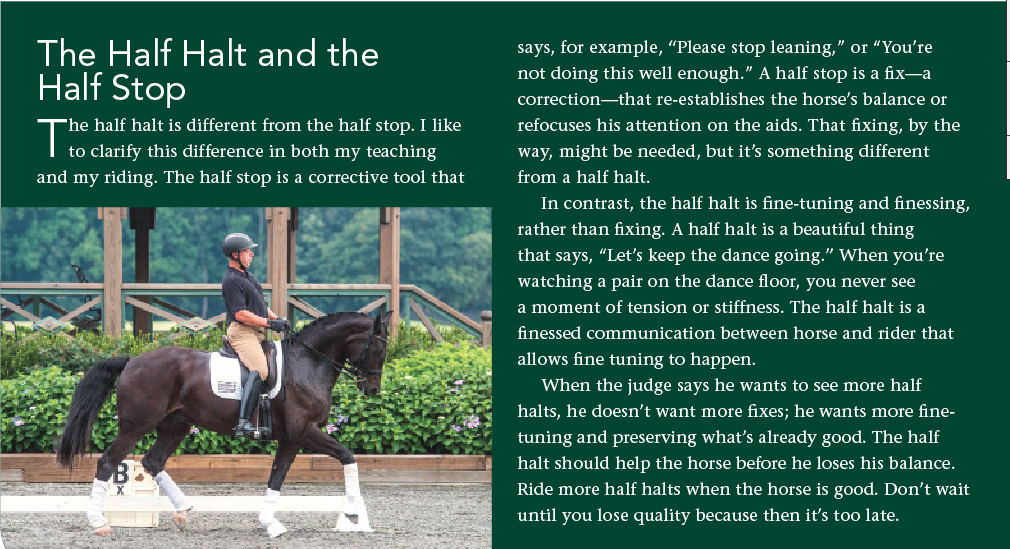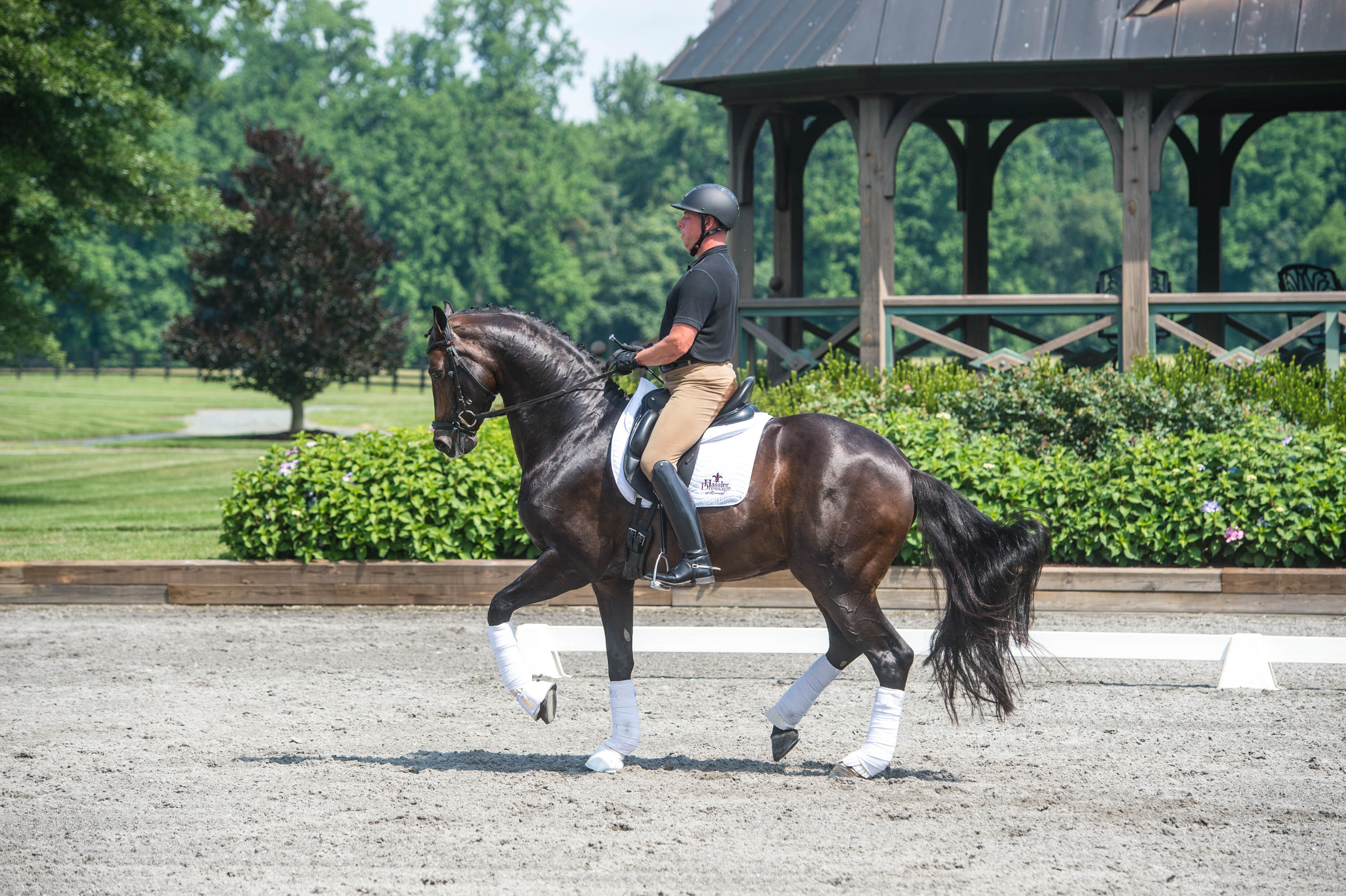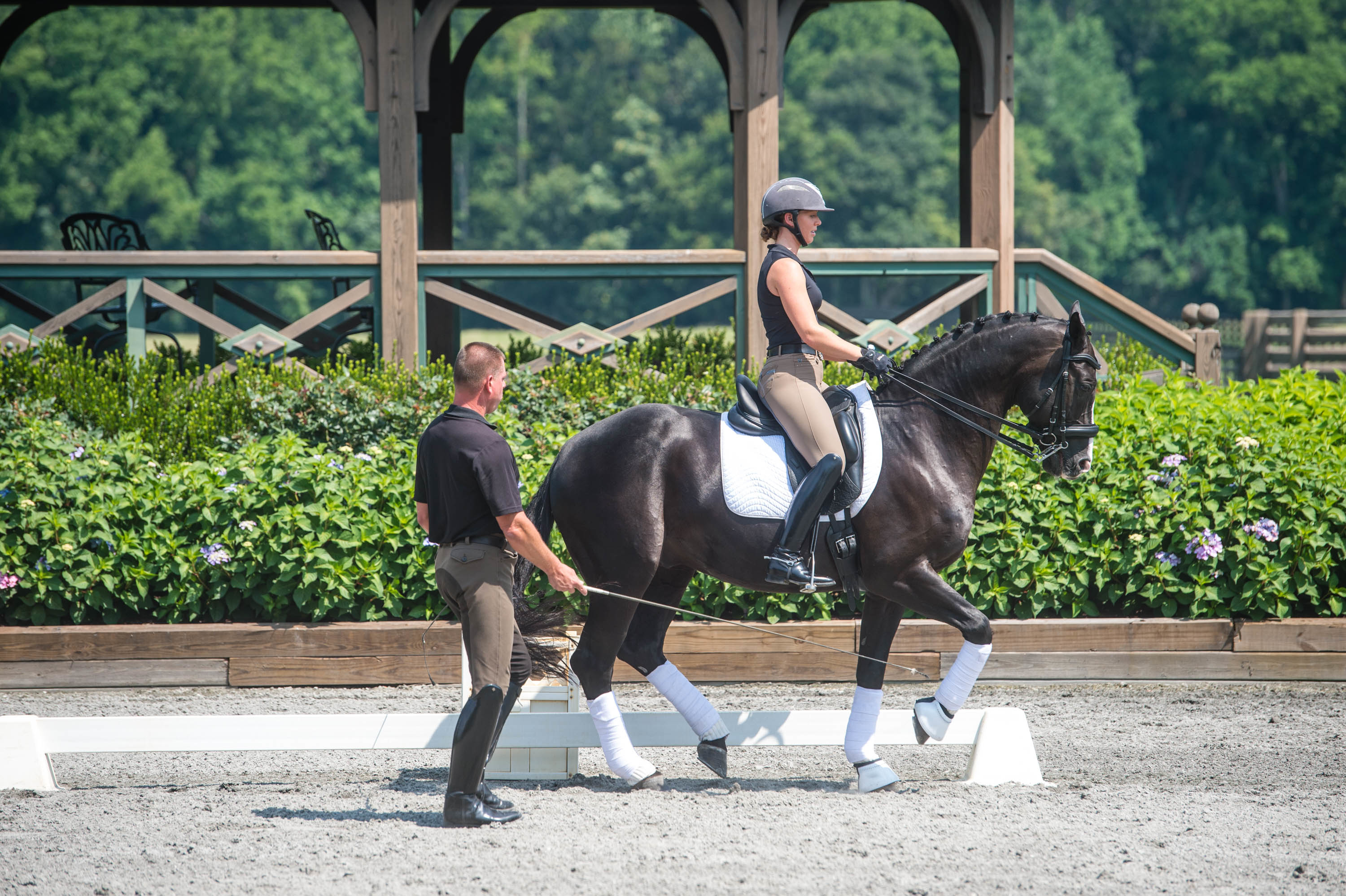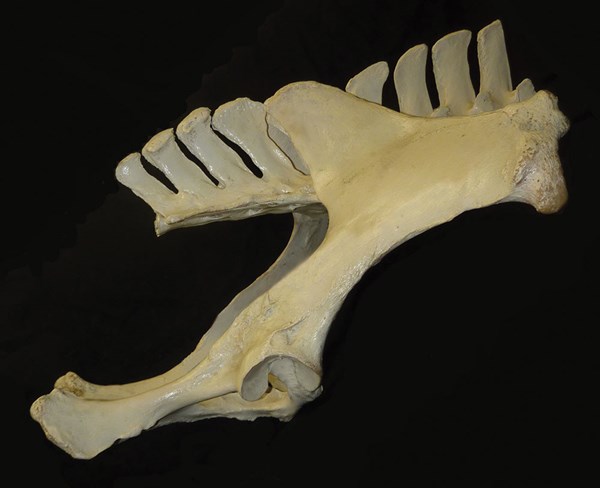Learning to develop collection is one of the most important aspects of horse and rider education. Collection can be poorly produced unless both horse and rider understand the principles of what it should achieve. In defining “collection,” I like to use the word “compression” because when you compress something such as a spring, it wants to push back. If you take a spring that’s 12 inches long and you compress it 1 inch, it wants to push back that 1 inch. If you think of collection as “fluid compression that wants to push back,” you’re ahead of the game, so don’t lose that concept!


What is Perfect Collection?
I often compliment a rider whose horse is cantering with expression, but then when I ask that rider to show me how she collects the canter, the quality is often lost. The bottom line is that collection should make the horse more beautiful than he was beforehand, not less beautiful. If the horse loses the expression, the elevation, the beautiful contact, the energy, the fluidity of the gait or the way his legs are animating, we can’t be satisfied that we’ve achieved collection.


As you ask for a degree of collection, you should feel a gradual yet energetic coiling, and for every degree of ground coverage that is reduced in collection, your horse should come up that much higher. His inclination from the beginning should be to lower the croup and lift in the shoulders. Period. Your horse should understand that clearly.
Then later, when you’re asking for higher collection in, for example, the preparation for a pirouette in the Prix St. Georges, your horse knows to compress or collect himself and the croup becomes lower and the shoulders higher. When you’re going from an extended canter to a collected canter, he still has that concept that the croup is lowering and the forehand is rising.
Collection requires an incredible ability to communicate with the horse’s body. You must be able to show the horse how to collect fluidly without running through you, dropping behind the leg or falling left or right. These resistances are often simply a lack of understanding in the horse. Here are the exercises I use to help my horses understand collection.
Collecting the Canter
Canter is a very natural gait from which to learn collection because the horse can innately canter very fast or almost in place. Trotting is different, more artificial and usually more difficult, so let’s start in canter.
I teach collected canter in two ways. I start some horses with Exercise 1, “Schooling through the Numbers,” and some with Exercise 2, “Changing the Balance Rapidly.” However, eventually, your horse needs to understand both.

Exercise 1: Schooling through the Numbers
In this exercise, I ask my horse for collection very gradually, thinking about the rhythm and the speed—or ground coverage—of the canter. For purposes of illustration, we might consider that the speed of a quality working canter is 15 mph, the Third Level collected canter might be 12 mph and the FEI collected canter of the Prix St. Georges might be 10 mph. Finally, the highly collected canter in a pirouette is only 1 mph.
How do we get from 15 mph to 12 to 10 and finally from 10 to 1? Try this exercise to coach your horse to quality collection.
For the Horse Just Learning Collection:
Step 1: Start in your working canter at 15 mph. Within the rhythm of canter, go to 14 mph. That slight reduction in ground cover should translate into more animation. The rhythm shouldn’t get choppy, slow or tense. The contact should remain the same. Confirm the quality and comfort of each step and when 14 mph feels good, try 13 and then 12. When 12 is comfortable and beautiful, try 11 and then 10, which is approximately a Prix St. Georges canter.
Step 2: Slowly—one step at a time—go from your 10-mph collected canter to 11 and gradually back to your 15-mph working canter.
For the Educated Horse:
Step 1: The Prix St. Georges horse has a collected canter that might be about 10 mph. Ask for a 9, and if that 9 feels comfortable for a few strides, you can go to 8, and if 8 feels supple and you’ve retained the beauty of it, then try for a 7. Make seven comfortable and then go to 6. Make 6 comfortable and go to 5, and so on.
Step 2: Next, work your way back up to 10, one step at a time.
What he should learn: Your horse should have the experience, the feel and the understanding of gradually utilizing the rhythm to coil, lower the croup, lift his shoulders and shift his balance. Because the exercise is so gradual in nature, it has the advantage of building confidence as well as understanding. This method is ideal for nervous and sensitive horses. But later you will have to mature the process so you can go through the numbers much more rapidly without losing any of those positive qualities. That nervous, sensitive horse will eventually need to understand Exercise 2: “Changing the Balance Rapidly.”
What you should learn: The rider who asks for collection this gradually has the tendency to use the aids more appropriately and rhythmically than the rider who is trying to make a sudden change and might be inclined to grip and hold.
Ultimately, however, the goal isn’t just to get through the numbers gradually; you must teach the horse how to shift his balance promptly, again without losing fluidity in the back or any of the other basic qualities. The power and compression shouldn’t get choppy, he shouldn’t lose his balance, he shouldn’t feel any tension in his ears or in his tail. He shouldn’t feel different in the contact. You’ll learn how to meet the needs of your horse whether he is lazy or hot.


Exercise 2: Changing the Balance Rapidly
With a lazier horse, you’ll want to make a change of balance more rapidly to add some energy and inspiration to him and then do it more fluidly later. With this lazier horse, you want the rapid change of balance to say, “Come on! Wake up and do it now!” Then, after your horse is awake, you go back to Exercise 1—going through the numbers with fluidity and getting the beauty of it. With the sensitive horse, after you gradually go through the numbers, he must learn to do it quickly because, in fact, a rapid change of balance is often needed. All horses need to do it both ways. You want to do it fluidly with rhythm and comfort and you want to do it rapidly to get a complete balance shift.
Where do you do your exercises?
In doing your exercises, figure out what lines and patterns are best for your particular horse. It may be on a straight line or a bent line. Does your horse do better on:
• a 20-meter circle?
• a short diagonal?
• a long side?
• in counter canter?
We don’t talk enough about collecting the canter with counter flexion. Some horses collect more easily that way, perhaps because the weight of the horse’s head and neck are no longer on the inside shoulder so it’s lighter and freer and can come off the ground more easily. Also, the horse is more easily aligned and the rider’s inside rein isn’t blocking, which allows the inside hind leg to jump through instead of into a holding inside rein. For these reasons, explore counter flexion, but then you will need to go back to the true principles with true positioning. Explore how best to get collection beautifully in canter.
Collecting the Trot
To me, collection in the trot has a very different feel. The principles of what we want to achieve in collection are the same, but the way in which you create it is very different. In the trot, we must be very careful not to muddle the clarity of the rhythm and tempo of the very defined collected, medium and extended trots and the very clear piaffe and passage. These gears must be well established and understood by the horse. The collected trot, for example, can’t become passagey. So going “through the numbers” is an unnatural exercise in trot and it can confuse horses. The horse should know his performance trot with whatever degree of collection is appropriate. For example, the Third Level horse will have a different degree of collection from that of a Grand Prix horse. Correct use of the half halt is the ultimate goal when developing collected trot.



The Half Halt
The half halt is a beautiful, effortless way to ask your horse to engage and shift his balance without losing rhythm, relaxation or any aspect of the contact. The half halt communicates this to your horse: shift your balance and compress while retaining your beautiful energy, suppleness and contact.
Ask yourself: When I do a half halt, am I getting compression and animation or am I getting flattening, slowing down, loss of energy or a horse that’s bracing or leaning?
How to teach that: The principles are the same as in the canter. You start with the slightest momentum change in which you’re not covering quite as much ground in the trot and you feel your horse understands the principle of shifting his balance and engaging.
When it’s right: The horse compresses, lowers the croup, gets tall in the withers and the gait becomes more beautiful and cadenced, inviting a transition to piaffe or passage. If the half halt isn’t beautiful, then the transition from trot to piaffe isn’t going to be beautiful.
When to ask for more power: Only when half halts are beautifully performed, do we have the right to ask for more power in, for example, an extension. If the half halts aren’t rhythmic, effective and easy, you have no right to add pressure—either from the saddle or from a person on the ground. That’s the best way I know to get a horse to run away or get nervous and scared.
The half halt is the hallway into the horse’s body and into his mental understanding of how to adjust his gait. When the horse understands the half halt, he understands how the degree of his collection can become greater. When the rider learns to ride forward to a greater degree of collection without loss of rhythm or suppleness, he has the key to developing his horse’s collection.
High Collection with Help from the Ground

Collection can be developed with the assistance of a ground person—either with the rider on top or not. There are pros and cons to these two methods. If you have a skilled person on the ground without a rider and the horse trusts the handler, you can take the pressure off the horse by having no conflict of aids. In this case, you never disturb the confidence of the horse-and-rider partnership and their communications always have the same meaning. The horse can learn the concept of compressing and listening without disturbing the confidence of the rider. In some situations, this is excellent. In other situations, the horse might be nervous without the rider, and tension makes the horse worse. The horse might tighten his topline, lose rhythm or even bolt forward. In this case, a skilled rider can provide suppleness, stability and confidence while the ground person assists by providing the incentive for the actual piaffe. The person on top is doing exactly what we discussed throughout this article, which is providing the harmonious, supple topline before asking for piaffe.
Work in hand is not just a learning tool; it’s also a fitness tool. Some people say, “I’ll do ground work until he learns it and then I won’t need it any more.” In my opinion, that’s not quite the right thinking. When you have a ground person, the rider’s aids can be very refined because the ground person is a visual for the horse that he reacts positively to and as a result, you never get into the situation in which the horse is struggling and the rider riding with harsher aids. The ground person can just be the incentive program so the rider can stay soft and supple and the horse can get fitter until the work is effortless.
I’m a big fan of figuring out what’s the best way for each horse to learn. Some horses shouldn’t have ground work because they get nervous. Therefore, they shouldn’t have to do it. It’s a matter of exploring and figuring out what’s best for your horse.

Scott Hassler was the USEF National Young Horse Dressage Coach from 2005–2015, chaired the USDF sport-horse committee and has served on the USEF dressage committee for more than 10 years. A sought-after clinician, he has conducted many National Dressage Symposia for USEF, USDF and several national breed associations. Hassler Dressage is based in Loxahatchee, Florida.
This article first appeared in the October 2017 issue of Dressage Today.











